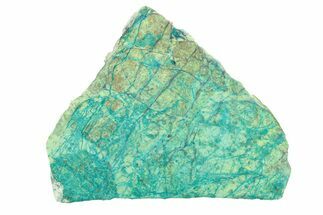This Specimen has been sold.
2.9" Keokuk Quartz Geode Pair - Iowa
This keokuk geode was collected from the Des Moines river bank in Farmington, Iowa. The interior of the geode is lined with sparkling quartz crystals, some coated with iron oxide providing the orange color. It comes with display stands.
Unlike most geodes that form in volcanic rock, Keokuk geodes are found in sedimentary rock. They started out as concretions of mud that formed around organic material about 340 million years ago. The outer shells of these concretions were subsequently replaced by chalcedony and the interiors of the concretions were dissolved, leaving a hollow space into which quartz crystals could grow. Most geodes are 2 to 5 inches wide, though specimens as large as two feet across have been found.
Keokuk geodes contain a variety of minerals, but quartz is dominant in most. Many geodes are filled with clear to white quartz crystals. Micro-crystalline quartz, or chalcedony, whose component crystals are too small to be seen with the naked eye, forms the outer shell. Chalcedony layers also encrust the interior walls of many geode cavities, covering the surfaces of the earlier-generation quartz crystals in a variety of colors, including white, gray, blue, yellow and orange. Calcite is also a common mineral in many geodes, though seventeen other minerals have been identified in Keokuk Geodes, including pyrite and sphalerite.
The area around Keokuk, Iowa is sometimes referred to as “the geode capital of the world". In 1967, these geodes were even named the official state rock of Iowa. Geodes have been collected from the Lower Warsaw Formation within about 100 miles of the city for over 150 years.
Keokuk geodes contain a variety of minerals, but quartz is dominant in most. Many geodes are filled with clear to white quartz crystals. Micro-crystalline quartz, or chalcedony, whose component crystals are too small to be seen with the naked eye, forms the outer shell. Chalcedony layers also encrust the interior walls of many geode cavities, covering the surfaces of the earlier-generation quartz crystals in a variety of colors, including white, gray, blue, yellow and orange. Calcite is also a common mineral in many geodes, though seventeen other minerals have been identified in Keokuk Geodes, including pyrite and sphalerite.
The area around Keokuk, Iowa is sometimes referred to as “the geode capital of the world". In 1967, these geodes were even named the official state rock of Iowa. Geodes have been collected from the Lower Warsaw Formation within about 100 miles of the city for over 150 years.
SPECIES
Quartz
LOCATION
Des Moines River Bank, Farmington, Iowa
SIZE
2.9" wide
CATEGORY
SUB CATEGORY
ITEM
#91393
 Reviews
Reviews












